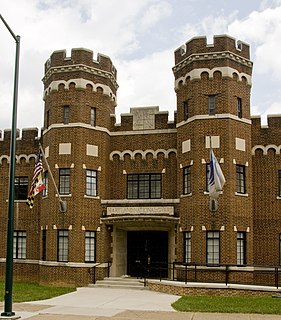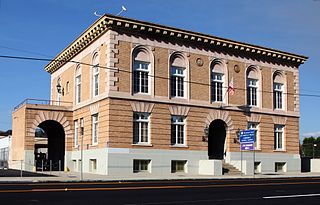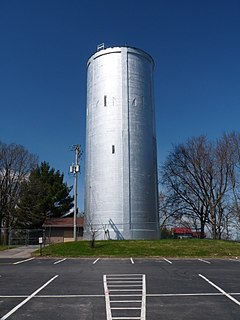 W
WThe James Bothwell Water Tank House is a water tank house located on a farm 3.25 miles (5.23 km) north of Jerome, Idaho. The building was constructed circa 1926 for James Bothwell, a local lawyer and farmland investor. Bothwell built the tank house and a well on the property to help provide water for the farm. The building was constructed with lava rock by stonemason John Gott, who was trained in Germany. It is one of two original rock water tank houses remaining in Jerome and Lincoln Counties.
 W
WThe George E. Turner Power Plant was a coal-burning, and later oil-burning, electrical power plant constructed on the north shore of Lake Monroe, in Enterprise, Florida, United States in 1926. The plant operated as an oil-burning power plant until 1994, providing electrical power to more than 300,000 homes during its peak. The plant was decommissioned in 1994, and occasionally used as a filming location for several television productions. The plant was razed in 2007, and the site now utilized as an ecological buffer zone.
 W
WHagerstown Armory is a historic armory located at 328 N. Potomac Street in Hagerstown, Washington County, Maryland, United States. It is a two-story Flemish bond brick structure with full basement emulating a Medieval fortification, built in 1926. The front facade features a central block offset by two, three-story towers. Tower tops are characterized by a ring of scalloped stone molding, surmounted by a ring of brick dentils, and topped by two crenelles per side with stone caps. The center section is topped by two crenelles with stone caps with stone tablet bearing the seal of the State of Maryland centered between them.
 W
WThe Highland Park Police Station on York Boulevard in the Highland Park section of Los Angeles, California, USA is the city's oldest surviving police station. Closed in 1983, the station is now operated as the Los Angeles Police Museum. It has been designated as a Historic Cultural Monument and listed on the National Register of Historic Places.
 W
WThe Japanese Hydro-electric Power Plant is a former hydroelectric power generation plant and historic site in Kolonia, the capital of Pohnpei State in the Federated States of Micronesia. The site is historically and culturally important as a representative of three different eras in the island's history. The site is important in the culture of Pohnpei as a location of high-quality stones gathered for use in ritual ceremonies involving the pounding of kava and drinking preparations from the plant. In the early 1900s, when Pohnpei was administered as part of German New Guinea, the German administration established an experimental forest, planting a diversity of trees from around the world, some of which continue to thrive in the area. Finally, in the 1920s, during the Japanese South Seas Mandate, a hydroelectric facility was built here. When the property was listed on the United States National Register of Historic Places in 1976 the concrete power plant building and water catchment basin survived.
 W
WThe Lanark Hydro Electric Scheme refers to two hydroelectric plants in the Clydesdale area of South Lanarkshire, Scotland. They take in water from the Falls of Clyde.
 W
WThe Marked Tree Lock and Siphons are a flood control facility on the St. Francis River in Poinsett County, Arkansas. These facilities are located about 9 miles (14 km) north of Marked Tree. Built in 1926, the lock is located on a now disused and partially filled artificial channel west of the main river. It has a concrete trough about 130 feet (40 m) long and 30 feet (9.1 m) high, with a small brick control house from which four gates are operated to regulate water flow through the lock. The lock gates have been removed and that area filled in and topped by a roadway. The siphons are located on a levee that impounds the main river channel several hundred feet upstream from the lock, and consist of a series large metal tubes, whose ends are mounted in submerged concrete structures above and below the levee. The siphons were built in 1939 to solve the problem of water flow regulation in the wake of repeated major flooding events on the river, and are described by the United States Army Corps of Engineers as unique in the nation for their scope and efficiency.
 W
WThe Muscatine County Home Dairy Barn, also known as the Old Barn, is a historic building on the west side of Muscatine, Iowa, United States. The barn was built in 90 days on the county home property in 1926. It replaced other barns that had been struck by lightning and were destroyed by the resulting fire. The home was an early form of welfare system known as the poor farm. It housed indigent, homeless, or disabled people who in turn worked on the farm to cover their costs of care and food. The barn was nearly torn down in 2006 when a group of volunteers called the Friends of the Old Barn acquired and restored it. It was also in danger of being torn down in 2017 because of its lack of utilities when a nearby building which provided them to the barn was slated to be torn down. The barn is now a museum located near the Muscatine Arboretum and the Muscatine County Environmental Learning Center. It was listed on the National Register of Historic Places in 2019.
 W
WThe Neillsville Standpipe is located in Neillsville, Wisconsin.